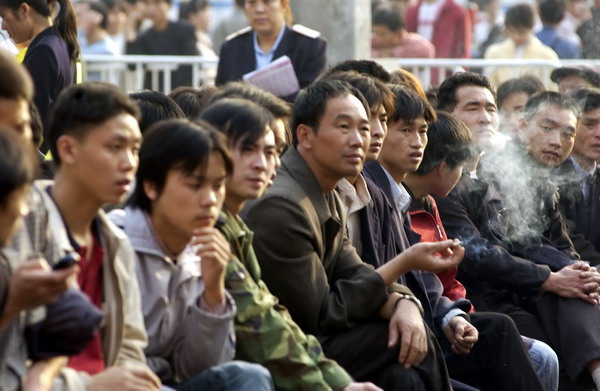Smokers refusing to pack it in
Updated: 2011-10-31 07:02
By Qiu Quanlin in Guangzhou and Duan Yan and Cui Jia in Beijing (China Daily)
|
|||||||||
|
 Smoking is not allowed at Guangzhou Railway Station and other government buildings, but it goes on anyway. Enforcement of the year-old regulation is spotty. [Photo/provided to China Daily]
|
Lack of legislation and huge profits make ban hard to enforce, report Qiu Quanlin in Guangzhou and Duan Yan and Cui Jia in Beijing.
The reaction by the elderly gentleman he caught smoking in Guangzhou's main bus station surprised Chen Weiguang, deputy director of the Standing Committee of the Guangzhou Municipal People's Congress.
"Do you know that smoking is prohibited in public in Guangzhou?" Chen asked him.
The smoker, unprepared for the question let alone the bevy of inspectors and trailing journalists, reached into his pocket for a pack of cigarettes and handed one to Chen. "Have one?"
Chen laughed at the nervous offer but declined.
Chen was leading an inspection trip on Oct 13, part of a three-day enforcement review the congress had ordered following the introduction one year earlier of a smoking regulation that was once considered the strictest in China. The regulation was the first to ban smoking in government buildings.
However, for anti-smoking advocates, that smoker's reaction was a dismal and ironic moment in their efforts to cure the addiction to nicotine in a country with more than 356 million smokers. About half of China's 300-plus cities now limit smoking in public, but ineffective enforcement is typical.
The fundamental reason, these advocates say, is an absence of government resolve because tobacco taxes provide a sizable part of government revenue.
"I think these so-called surprise inspections are just another showcase," Li Ziliu, Guangzhou's former mayor, said on Oct 24 at a symposium about Guangzhou's regulations of smoking. "Tobacco control needs to start with government leaders."
During one surprise visit to the city government building, inspectors caught staff trying to sneak the ashtray out of an official's office.
China has no national law for smoking control, and it didn't meet the Jan 9 deadline to ban smoking in public indoor places, as it pledged to do under the World Health Organization's Framework Convention on Tobacco Control. The global anti-tobacco treaty came into force in China five years ago.
Improvements have been seen in some cities where smoking regulations were implemented in time for international events, such as the 2008 Beijing Olympics, 2010 Shanghai Expo and the Guangzhou Asia Games last November.
But when the events were over, the rules became loosely enforced, and loopholes have made these regulations ineffective in weaning China off tobacco. Smokers in public places continue to puff away with abandon.
|
 If you're caught smoking against city regulation, what can you do? This man tried off ering a cigarette to a Guangzhou official, who said 'no thanks.' [Photo by Zou Wei/for China Daily]
|
By the numbers
Thirteen months after Guangzhou implemented curbs on smoking in public, after more than 120,000 checks and 4,000 rectification notices, only one person and five companies have been punished for breaking the regulation. Fines totaled 26,550 yuan ($4,176).
Fifteen government departments - including traffic, tourism, health and education - and 2,673 of their staff members are responsible for enforcing the regulation. They are trying to manage an estimated 2.3 million smokers in the city, 21.7 percent of its population older than 15.
Enforcement starts with a warning and escalates to a rectification order, a written requirement to change behavior. If an individual or organization refuses to comply, law enforcement officers can fine individuals 50 yuan and organizations 3,000 to 5,000 yuan. The progression from warning to fine usually takes 40 to 60 days.
"These law enforcement departments are often reluctant to enforce tobacco control regulations, and there is buck-passing among these departments," said Jin Gensheng, a member of the Standing Committee who is in charge of the anti-tobacco enforcement inspections. "There is only one staff member from the city's Patriotic Public Health Campaign Office coordinating part-time with these departments."
That office was at odds with the government when the regulation was drafted last year because it advocates a 100 percent smoking ban in public and work areas. Chen Hanwei, a deputy director in the office, said that unlike the other departments, the office is not empowered to enforce the regulation.
Similarly, in the nearly three years since Beijing required restaurants and bars to provide nonsmoking sections, not a single person or company has been fined for breaking the rule.
Secondhand smoke
Even when current regulations are well enforced, a partial ban of smoking will not protect people from exposure to secondhand smoke, and it is not enough for China to meet its obligations under the tobacco control treaty. In many restaurants and bars, there is no barrier between smoking and nonsmoking areas.
Currently, 740 million people, including 182 million children, are exposed to secondhand smoke, according to China's Global Adult Tobacco Survey of 2010. Secondhand smoke can increase the risk of heart disease and cancer, and can cause sudden infant death syndrome in children who are exposed or whose mothers were exposed during pregnancy.
"What is the point of having a smoking and nonsmoking area when the whole place is filled with smoke?" Lin Kainan asked. A 32-year-old housewife, she was sitting in a cafe in Beijing's Chaoyang district, drinking her coffee beneath a thick cloud of smoke on a Saturday afternoon.
"When I was pregnant last year, I read in a book that secondhand smoke could induce miscarriage," she said, so she asked people smoking near her in restaurants to put out their cigarettes. "Many smokers would stop, but devoted smokers would pick up the ashtray on the table and tell me I was sitting in the smoking section."
Beijing's lawmakers have talked for years about banning smoking in indoor public spaces. In fact, when the measure requiring nonsmoking areas was implemented in 2008, health officials set the goal to ban smoking entirely by 2010.
Mao Yu, spokesman and deputy director of the Beijing Municipal Health Bureau, said at a news conference last December that Beijing would be 100 percent smoking-free in public indoor venues, offices and public transportation by the end of 2015. That announcement means the deadline for the goal was pushed back five years.
Cui Xiaobo, a professor at Capital Medical University, said it would be unrealistic for China to implement its part of the tobacco control treaty without national legislation, which wouldn't be easy in any case.
"I'm afraid that the root cause is still governments' lack of resolution," Cui said. "The introduction of tobacco-control law and regulations is bound to affect some of the benefits of some government departments, resulting in some changes."
Revenue source
Money is at the center of the problem when it comes to resolving to ban smoking in public. Governments are addicted to the economic gains generated by the tobacco industry. However, health experts and economists argue that the medical and social costs of smoking have already exceeded the tax revenues generated by the tobacco industry.
China is both the world's largest producer and the largest consumer of tobacco, in roughly equal measure. Production has been steadily growing, from 589.9 billion cigarettes in 1978 to about 2.38 trillion last year, according to data from the State Tobacco Monopoly Administration.
Tobacco tax and profits contributed 7.27 percent of the central government's total revenue last year, according to Professor Mao Zhengzhong, deputy chairman of the China Health Economics Association.
In China's largest tobacco-producing province, Yunnan, tobacco tax contributed 92.08 percent of local government's revenue in 2009 and 77.81 percent in 2010, Mao said. Actual tobacco tax revenue rose from 64.2 billion yuan to 67.8 billion yuan, but the government's overall revenue rose more significantly.
The tobacco industry has always said that declining tobacco consumption would lead to economic losses. "They claimed that China should not urge its people to stop smoking through price increases and legislation," said Yang Gonghuan, deputy head of the Chinese Center of Disease Control and Prevention (CDC).
In 2005, more than 1.2 million Chinese died of smoking-related diseases. Health experts have predicted that, if left unchecked, smoking-related deaths will reach 3 million a year by 2050. That warning comes from "Tobacco Control and China's Future", a joint assessment prepared and reviewed by Yang and a group of public health experts and economists that was published in January.
Economic burden
Research from several Chinese economists has indicated that the world's largest tobacco industry is not contributing to China's economic growth but is hurting it.
Using 2005 figures as an example, Professor Li Lin of Peking University estimated that direct and indirect costs of smoking - including healthcare and lost work productivity - totaled nearly 300 billion yuan, while the tobacco industry generated 240 billion yuan in taxes and profits.
Professor Mao's research found that in 2008, China's economic burden of smoking was as high as 320.57 billion yuan.
Economists agree that increased taxation is one of the most effective ways to curb tobacco use, but only if it is reflected in the retail price of cigarettes.
China raised its tax on cigarettes in May 2009, resulting in increased government revenue. However, some cigarettes that had been taxed at a higher rate were downgraded to a lower rate, so their taxes declined under the adjustment.
"It looked like we had a big win in the battlefield, but the victory is not as sweet as we thought it would be," the CDC's Yang said. She thinks this approach, of minimizing the practical effects of the tobacco tax, might be wasting the anti-smoking efforts. "There is still a long way to go in the fight against tobacco."











